Gallery
- Bacchante
- Marriage of Bacchus and Ariadne
- Satyrs with Silenus
The Bacchic Cassone was a 1505-1510 panel painting by Cima da Conegliano, produced as the front panel of a decorated cassone. It is now split into four portions, one in a private collection, two in the Philadelphia Museum of Art (Bacchant [1] and Drunken Silenus [2] ) and one in the Museo Poldi Pezzoli in Milan (Marriage of Bacchus and Ariadne). [3] [4]

In Greek mythology, Silenus was a companion and tutor to the wine god Dionysus. He is typically older than the satyrs of the Dionysian retinue (thiasos), and sometimes considerably older, in which case he may be referred to as a Papposilenus. The plural sileni refers to the mythological figure as a type that is sometimes thought to be differentiated from a satyr by having the attributes of a horse rather than a goat, though usage of the two words is not consistent enough to permit a sharp distinction. The etymology of God Seilenos comes from σείω – shake, move to and fro and ληνός – wine, and meaning "Shattering, drunken god of wine." Undoubtedly, Seilenos presides over other daemones and is related to musical creativity, prophetic ecstasy, drunken joy, drunken dances and gestures.
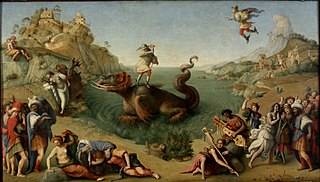
Piero di Cosimo, also known as Piero di Lorenzo, was an Italian painter of the Renaissance.

A cassone or marriage chest is a rich and showy Italian type of chest, which may be inlaid or carved, prepared with gesso ground then painted and gilded. Pastiglia was decoration in low relief carved or moulded in gesso, and was very widely used. The cassone was one of the trophy furnishings of rich merchants and aristocrats in Italian culture, from the Late Middle Ages onward. The cassone was the most important piece of furniture of that time. It was given to a bride and placed in the bridal suite. It would be given to the bride during the wedding, and it was the bride's parents' contribution to the wedding.

Ariadne auf Naxos, Op. 60, is a 1912 opera by Richard Strauss with a German libretto by Hugo von Hofmannsthal. The opera's unusual combination of elements of low commedia dell'arte with those of high opera seria points up one of the work's principal themes: the competition between high and low art for the public's attention.

In Greek mythology and religion, the thiasus, was the ecstatic retinue of Dionysus, often pictured as inebriated revelers. Many of the myths of Dionysus are connected with his arrival in the form of a procession. The grandest such version was his triumphant return from "India", which influenced symbolic conceptions of the Roman triumph and was narrated in rapturous detail in Nonnus' Dionysiaca. In this procession, Dionysus rides a chariot, often drawn by big cats such as tigers, leopards, or lions, or alternatively elephants or centaurs.

Catullus 64 is an epyllion or "little epic" poem written by Latin poet Catullus. Catullus' longest poem, it retains his famed linguistic witticisms while employing an appropriately epic tone.

The Loves of the Gods is a monumental fresco cycle, completed by the Bolognese artist Annibale Carracci and his studio, in the Farnese Gallery which is located in the west wing of the Palazzo Farnese, now the French Embassy, in Rome. The frescoes were greatly admired at the time, and were later considered to reflect a significant change in painting style away from sixteenth century Mannerism in anticipation of the development of Baroque and Classicism in Rome during the seventeenth century.

The Borghese Vase is a monumental bell-shaped krater sculpted in Athens from Pentelic marble in the second half of the 1st century BC as a garden ornament for the Roman market; it is now in the Louvre Museum.

Sebastiano Ricci was an Italian painter of the late Baroque school of Venice. About the same age as Piazzetta, and an elder contemporary of Tiepolo, he represents a late version of the vigorous and luminous Cortonesque style of grand manner fresco painting.
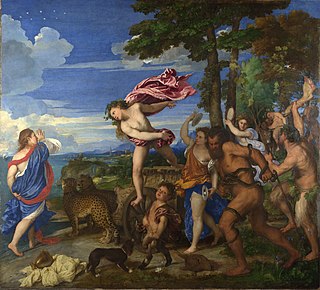
Bacchus and Ariadne (1522–1523) is an oil painting by Titian. It is one of a cycle of paintings on mythological subjects produced for Alfonso I d'Este, Duke of Ferrara, for the Camerino d'Alabastro – a private room in his palazzo in Ferrara decorated with paintings based on classical texts. An advance payment was given to Raphael, who originally held the commission for the subject of a Triumph of Bacchus. At the time of Raphael's death in 1520, only a preliminary drawing was completed and the commission was then handed to Titian. In the case of Bacchus and Ariadne, the subject matter was derived from the Roman poets Catullus and Ovid.

The Villa of the Mysteries is a well-preserved suburban ancient Roman villa on the outskirts of Pompeii, southern Italy. It is famous for the series of exquisite frescos in one room, which are usually thought to show the initiation of a young woman into a Greco-Roman mystery cult. These are now among the best known of the relatively rare survivals of Ancient Roman painting from the 1st century BC.
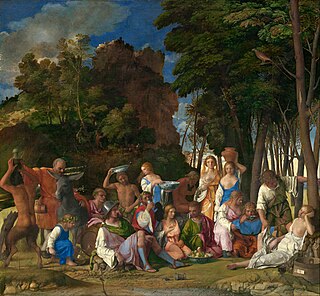
The Feast of the Gods is an oil painting by the Italian Renaissance master Giovanni Bellini, with substantial additions in stages to the left and center landscape by Dosso Dossi and Titian. It is one of the few mythological pictures by the Venetian artist. Completed in 1514, it was his last major work. It is now in the National Gallery of Art in Washington D.C., which calls it "one of the greatest Renaissance paintings in the United States".

The Triumph of Bacchus is a painting by Diego Velázquez, now in the Museo del Prado, in Madrid. It is popularly known as Los borrachos or The Drinkers.

The Sarcophagus of the Triumph of Bacchus is a monumental ancient Roman stone sarcophagus of Carrara marble. The style and high quality of its reliefs and the choice of Bacchus triumphing over India as its subject suggests it came from a Roman workshop and possibly dates to the start of the 3rd century, from the reign of Caracalla to that of Elagabalus. It was rediscovered around 1800 on the Saint-Just hill in Lyon, France, during the rebuilding of the église Saint-Irénée. At that time it was broken into three pieces and reburied 4m below the church's staircase, from where it was exhumed in 1824 by A. Comarmond during restoration work on the church. It is now in the Gallo-Roman Museum of Lyon.
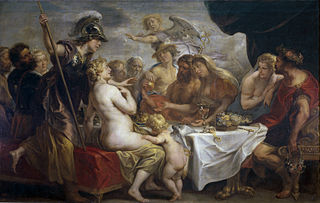
The Feast of the Gods or Banquet of the Gods as a subject in art showing a group of deities at table has a long history going back into antiquity. Showing Greco-Roman deities, it enjoyed a revival in popularity in the Italian Renaissance, and then in the Low Countries during the 16th century, when it was popular with Northern Mannerist painters, at least partly as an opportunity to show copious amounts of nudity.
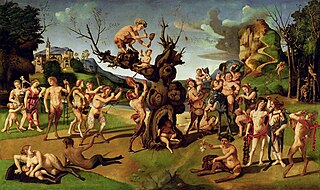
The Discovery of Honey by Bacchus is a painting by Piero di Cosimo from c. 1499. It depicts the god Bacchus and the discovery of honey, as described in the ancient Roman poem Fasti by Ovid. It is in the collection of the Worcester Art Museum in Worcester, Massachusetts.

Ecce Homo or Christ Wearing the Crown of Thorns is a oil on oak panel painting of the Ecce Homo subject by Peter Paul Rubens, executed c. 1612, now in the Hermitage Museum, in Saint Petersburg. The Hermitage also houses an oil study for its figure of Pilate.

Bacchus, Venus and Ariadne is an oil painting executed in Venice in 1576–77 by the Italian painter Jacopo Tintoretto which hangs in the Sala dell'Anticollegio at the Doge's Palace (the Pallazzo Ducale} in Venice. It is one of four almost square paintings on mythological subjects in the same room which were commissioned to celebrate the government of Doge Girolamo Priuli.

Young Couple is a c.1505-1510 Carrara marble relief sculpture by Tullio Lombardo, now in the Kunsthistorisches Museum in Vienna. It was previously known as Bacchus and Ariadne, whilst a recent study by Claudia Kryza-Gersch has suggested the alternative title of The Singing Poet and His Lover.

Ariadne Abandoned by Theseus was painted in England in 1774 by the Swiss artist Angelica Kauffman. It is currently displayed in the Museum of Fine Arts, Houston, as a gift from Mr. and Mrs. Harris Masterson III. It is an oil painting on canvas. Ariadne Abandoned by Theseus is one of Kauffman's few history paintings depicting a single figure.